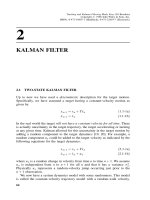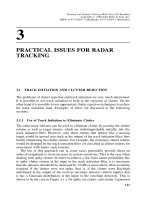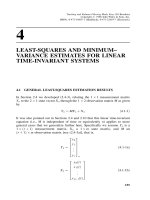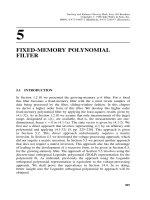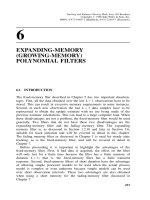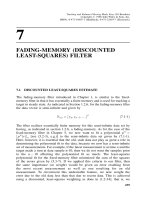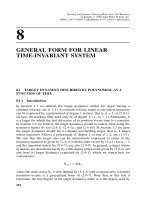Fractions and decimals made easy
Bạn đang xem bản rút gọn của tài liệu. Xem và tải ngay bản đầy đủ của tài liệu tại đây (6.71 MB, 50 trang )
Fractions
and
Decimals
Made Easy
Rebecca Wingard-Nelson
Illustrated by Tom LaBaff
This page intentionally left blank
Fractions and
Decimals
Made Easy
Rebecca Wingard-Nelson
Enslow Elementary, an imprint of Enslow Publishers, Inc.
Enslow Elementary® is a registered trademark of Enslow Publishers, Inc.
Copyright © 2005 by Enslow Publishers, Inc.
All rights reserved.
No part of this book may be reproduced by any means without the written permission
of the publisher.
Library of Congress Cataloging-in-Publication Data
Wingard-Nelson, Rebecca.
Fractions and decimals made easy / Rebecca Wingard-Nelson.
p. cm. — (Making math easy)
Includes index.
ISBN 0-7660-2513-6 (hardcover)
1. Fractions—Juvenile literature. 2. Decimal fractions—Juvenile literature.
I. Title. II. Series.
QA117.W56 2005
513.2'6-dc22
2005012670
Printed in the United States of America
10 9 8 7 6 5 4 3 2 1
To Our Readers: We have done our best to make sure all Internet Addresses in this
book were active and appropriate when we went to press. However, the author and the
publisher have no control over and assume no liability for the material available on those
Internet sites or on other Web sites they may link to. Any comments or suggestions can
be sent by e-mail to or to the address on the back cover.
Illustrations: Tom LaBaff
Cover illustration: Tom LaBaff
Contents
Introduction
What Is a Fraction?
Fraction Terms
Proper Fractions
Improper Fractions
Mixed Numbers
Comparing Fractions
Comparing Mixed Numbers
Equivalent Fractions
Estimating Fractions
Fractions in Measurement
Adding Fractions
Subtracting Fractions
What Is a Decimal?
Decimals and Fractions
Equivalent Decimals
Comparing Decimals
Rounding Decimals
Estimating Decimals
Adding Decimals
Subtracting Decimals
Further Reading
Internet Addresses
Index
4
6
8
10
12
14
16
18
20
22
24
26
28
30
32
34
36
38
40
42
44
46
47
48
Introduction
M
ath is all around, and an important part of
anyone’s life. You use math when you are
playing games, cooking food, spending money,
telling time, reading music, or doing any other
activity that uses numbers. Even finding a
television channel uses math!
4
Fractions and Decimals Are Everywhere
You use fractions every day. Every time you use
the word half, you are talking about a fraction!
Measurements often use fractions. For example,
3
a pencil could be 6 4 inches long; you might
1
need 2 cup of sugar for cookies; and your dog
1
might weigh 21 3 pounds.
Decimals are an important part of our money
system. Money amounts in dollars and cents
are written as decimals. Sports statistics, such
as batting averages and race times, are also
given as decimal numbers. The metric system is
a way to measure using decimals, instead of
fractions.
Using This Book
This book can be used to learn or review
fractions and decimals at your own speed. It
can be used on your own or with a friend, tutor, or
parent. Get ready to discover math . . . made easy!
5
What Is
F
ractions are numbers that stand for part of a
whole. A fraction may show part of one whole
thing.
This chocolate cake was
cut into 6 equal pieces.
One piece of the cake
is gone.
You can use a fraction to
show how much of the
cake is gone.
1
6
piece of cake is gone
pieces of cake in the whole cake
1
6 of the cake is gone.
6
a Fraction?
A fraction may show part
of one whole group.
fraction—Part
of one whole
thing or grou
p.
This is one whole group of elephants. Some of the
elephants are pink. You can use a fraction to show
how many in the group of elephants are pink.
3
8
elephants are pink
elephants are in the group
3
8 of the elephants are pink.
7
Fraction
A
ll fractions are made of two numbers, a top
number and a bottom number.
The bottom number is the denominator. It tells how
many equal parts are in the whole. The top number
is the numerator. It tells how many parts you are
talking about.
To help you remember which is which, think,
“D is for downstairs and denominator, so the
denominator goes on the bottom.”
numerator
denominator
1
4
number of parts you are
talking about
number of equal parts in
the whole
When you read a fraction, read the top number first.
Then read the bottom number using words like half,
thirds, fourths, or fifths.
1
4
This fraction is read as one fourth.
8
Terms
2
of this pie is left.
3
The fraction 2 is read as two thirds.
3
The bottom number, 3, tells
you there are three equal
pieces in the whole pie.
The top number, 2, tells you
that two of the parts are left.
1
of these socks are dirty.
2
1
The fraction 2
is read as
one half.
The bottom number, 2, tells
you there are two socks in
the whole group. The top
number, 1, tells you that
one of the socks is dirty.
9
Proper
A
fraction whose top number is smaller than its
bottom number is called a proper fraction.
1
3
1 is
smaller
than 3.
5
6
5 is
smaller
than 6.
2
7
2 is
smaller
than 7.
9
10
9 is
smaller
than 10.
All proper fractions have a value less than one.
This circle has 8 equal parts.
It is one whole circle.
If you are looking at less than 8 parts of the circle,
you are looking at less than one whole circle.
1 2 3 4 5 6
, , , , , , and 7 are all less than 1.
8 8 8 8 8 8
8
8
is the same as 1, so it is not a proper fraction.
8
10
Fractions
Proper fractions can be shown on
a number line between the
numbers 0 and 1.
Show
pr oper fractio
n–
A fraction wh
ose
top number is
smaller than
its
bottom numbe
r.
2
on a number line.
5
2
is less than 1. Draw a number line from 0 to 1.
5
1
0
The bottom number (denominator) is 5. That means
there are 5 equal parts in one whole. Divide the
number line from 0 to 1 into 5 equal spaces.
1
0
The top number (numerator) is 2. It tells you how
many of the sections of the number line you are
talking about. The numerator is 2, so count 2 spaces
from the 0.
0
2
5
1
11
Improper
A
n improper fraction has a top number that is
equal to or larger than the bottom number.
9
9
4
3
9 is
equal
to 9.
4 is
larger
than 3.
7
6
7 is
larger
than 6.
12
5
12 is
larger
than 5.
Fractions whose top and bottom number are the
same have a value of 1.
A garden is divided into 3 parts. All 3 parts
are planted with sunflowers. How much of
the garden is planted with sunflowers?
3
3
is the same as 1 whole.
The whole garden is planted with sunflowers.
12
Fractions
When the top number is larger
than the bottom number, the
fraction has a value greater than 1.
impr oper frac
tion—
A fraction wh
ose
top number is
equal
to or larger
than
its bottom nu
mber.
Here are three halves of a sweater. Three halves is
3
written as the fraction .
2
3 is greater than 2.
3
is greater than 1.
2
There is more than one sweater.
13
Mixed
A
mixed number is a mix of two kinds of
numbers. There is a whole number, such
as 2, and a proper fraction, such as 41.
whole number
2 41
fraction
When you read a mixed number out loud, you say
the whole number, the word and, then the fraction.
The mixed number 241 is read as two and one fourth.
What does a mixed number stand for?
The mixed number 241 is greater than 2 but less than 3.
1 Draw 0 through 3 on a number line.
2 Make four equal spaces between the whole numbers
2 and 3.
3 The first line you made after the number 2 is
than 2, or 241.
0
14
1
2
2 41
1
4
3
more
Numbers
One page of a sticker book holds 6 famous
monster stickers. Marlon has 12 full pages
of stickers, and one page with 5 stickers on
it. Write the number of pages of stickers as
a mixed number.
Write the number of full pages as
the whole number part.
12
There are 6 stickers on a
full page. Write 6 as the
denominator of the fraction part.
12 6
There are 5 stickers on the final
page. Write 5 as the numerator
of the fraction part.
12 65
5
Marlon has 12 6
pages of
famous monster stickers.
15
Comparing
Y
ou can compare two fractions to see which one
is greater. If the two fractions have the same
denominator, just compare the numerators.
2
5
3
5
same denominators (5)
numerator —T
he
top number in
a
fraction.
The numerator 2 is less than the numerator 3, so
2
3
the fraction 5
is less than the fraction 5
.
2
5
3
5
than.”
< means “less
ter than.”
> means “grea
16
2
5
3
< 5
Fractions
What if the denominators are different? You can
easily compare these fractions when the numerators
are the same.
1
3
1
8
— same numerators (1)
— different denominators
The denominators are different, but the numerators
are the same, 1.
There are the same number
of parts in both of these
fractions (1 part), but the
parts in 31 are larger than
the parts in 81 .
1
3
1
8
pb
When the numerators are the same, the fraction
with the smaller denominator is the larger fraction.
1
3
> 1
8
denominator —
The
bottom numbe
r in
a fraction.
17
Comparing
W
hen you are comparing
mixed numbers, look at the
whole number first.
4 32
6 21
whole number
mixed number
—A
number with
a whole
number and a
proper
fraction.
whole number
When mixed numbers have different whole
number parts (4 and 6), just compare the
whole numbers.
4 is less than 6, so 4 32 is less than 6 21.
432
18
< 621
Mixed Numbers
When mixed numbers have the same whole
number parts, just compare the fraction.
743
741
fraction
fraction
Since the mixed numbers 743 and 741 have the
same whole number part, 7, you compare the
fraction parts, 43 and 41.
743
741
The denominators are the same,
4, so compare the numerators,
3 and 1. Since 3 is more than 1,
the fraction 43 is more than the
fraction 41.
743
>
Remember, fr
actions
must have th
e same
numerators o
r
denominators
to be
easily compar
ed (se e
pages 16 and
17).
741
19
Equivalent
S
ome fractions, such as 21 and 63 , use different
numbers but have the same value.
1
2
2
4
3
6
8
16
8
All of these fractions (12 , 42 , 63 , and 16
) have equal
values. They are called equivalent fractions.
Let’s find an equivalent fraction of 12 . Multiply
or divide the top and bottom number by the
same number (other than zero). You can pick
any number you like. Let’s pick the number 3.
1 ϫ 3 ϭ 3
2 ϫ 3
6
The fractions 21 and 63 are equivalent, or equal.
20
Fractions
When there is no number that
both the top and bottom number
can be divided by, except 1, the
fraction is in simplest form.
4
Put 12 in simplest form.
The simplest
form
of a fraction
is
sometimes ca
lled
the fraction in
lowest terms.
The numbers 4 and 12 can both be divided by 4.
4 Ϭ 4 ϭ 1
12 Ϭ 4
3
4 and 1 are equivalent. There is
The fractions 12
3
no number that both 1 and 3 can be divided by,
except 1.
hen
Remember, w
r and
the numerato
re
denominator a
ction
equal, the fra
f 1.
has a value o
4 in simplest form is 1.
12
3
21
Estimating
Y
ou can estimate the value of a fraction by
comparing the numerator and denominator.
A When the numerator is about half of the
denominator, the value of the fraction is close to 12 .
5 . Half of the denominator,
Look at the fraction 12
12, is 6. The numerator, 5, is close to 6, so
5
12
is close to 12 .
B When the numerator is much less than half of the
denominator, the value of the fraction is close to 0.
Look at the fraction 16 . Half of the denominator,
6, is 3. The numerator, 1, is much less than 3.
1
6
is close to 0.
C When the numerator is much greater than half of
the denominator, the value of the fraction is close
to 1.
Look at the fraction 87 . Half of the denominator, 8,
is 4. The numerator, 7, is much greater than 4.
7
8
22
is close to 1.
Fractions
You can estimate the sum or difference of fractions
by estimating the value of each fraction first.
3
Jamal read 18 books last week. Then he read
5
another 26 books this week. About how many
books did Jamal read in the two weeks?
First estimate the value of each fraction.
183
265
3
1
8 is close to 2 ,
3 is close to
so 18
5
6 is close to 1,
5
so 26
is close to
121 .
3.
Now add the estimated fractions.
1 21
+ 3
4 21
Jamal read about 412 books
in the two weeks.
23


